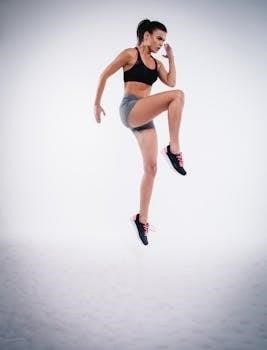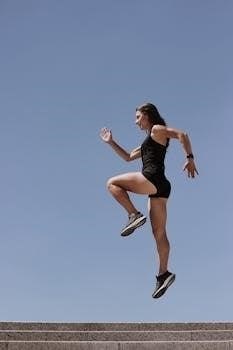Primal movement workouts focus on natural, functional movement patterns. These exercises enhance strength, mobility, and balance, mirroring our evolutionary roots. They use bodyweight and improve coordination, offering a unique approach to fitness, unlike traditional gym routines.
What is Primal Movement?
Primal movement is a fitness approach centered around fundamental human movement patterns, often referred to as the seven foundational movements. This method emphasizes functional strength, mobility, and balance by mimicking the ways our ancestors moved naturally. Think of activities like crawling, walking, running, bending, pushing, pulling, and twisting – these are all integral to primal movement. Unlike isolating individual muscle groups, primal movements engage multiple muscle groups simultaneously, leading to better coordination and overall body awareness. This approach also promotes a more efficient and effective way of training the body for everyday activities. Primal movement workouts often require no equipment and can be adapted for all fitness levels, from beginner to advanced. By focusing on these core movement patterns, individuals can build a solid foundation for improved physical function and well-being.

Core Primal Movement Patterns
Core primal movement patterns include seven foundational movements. These are hinge, squat, lunge, push, pull, twist, and gait. They form the basis of functional strength and mobility in primal workouts.
The Seven Foundational Movements
The seven foundational movements are the cornerstone of primal movement workouts, encompassing how humans are naturally designed to move. These movements include hinging, which involves bending at the waist; squatting, a fundamental lower body exercise; lunging, which works unilateral strength and balance; pushing, such as push-ups; pulling, like pull-ups; twisting, engaging the core through rotation; and gait, which includes walking and running. Each of these movements is a compound action, using multiple muscle groups, and enhances inter-muscular coordination. They improve general and sport-specific motor skills and overall biomotor abilities. These patterns promote a well-balanced training program, moving away from isolated muscle work, towards functional, multi-planar exercises. Mastering these movements leads to improved strength, mobility, and efficient everyday activities. These are not just exercises; they are the building blocks of human movement, applicable to all aspects of life.

Hinge Exercises
Hinge exercises, a core component of primal movement, involve bending primarily at the hips while maintaining a neutral spine. This movement pattern is essential for daily activities like lifting objects safely. Examples of hinge exercises include deadlifts, good mornings, and hip thrusts. These actions engage the posterior chain, strengthening the glutes, hamstrings, and lower back. Proper execution of hinge movements requires core stability and controlled eccentric motion, emphasizing intra-abdominal pressure. Hinge exercises improve hip mobility and promote better posture by counteracting the effects of prolonged sitting. They are crucial for developing functional strength, allowing the body to move efficiently and powerfully. This movement also enhances balance and coordination, making it a vital component of any well-rounded fitness regimen. By mastering the hinge, you build a strong foundation for more complex movements.
Squat Exercises
Squat exercises are fundamental to primal movement, engaging multiple muscle groups simultaneously. They involve lowering the hips while maintaining a stable core and neutral spine. A deep squat, even below parallel, enhances mobility and strengthens the lower body effectively. Variations include bodyweight squats, goblet squats, and pistol squats, offering progressions for all fitness levels. Squats improve leg strength, glute activation, and core stability. They are crucial for everyday activities like sitting, standing, and lifting. Proper form in squatting involves maintaining a neutral spine and controlled movements, preventing injuries. Regular squat practice boosts balance and coordination, and improves overall functional fitness. Squats prepare the body for more complex movements, making them essential for a well-rounded fitness program. They promote inter-muscular coordination and overall body strength. Mastering the squat form is a key component in primal movement training.
Lunge Exercises
Lunge exercises are a cornerstone of primal movement, promoting unilateral strength and balance. They involve stepping forward or backward, bending both knees to create a 90-degree angle. Lunges target the quadriceps, hamstrings, and glutes, improving leg strength and stability. Variations include forward lunges, reverse lunges, and lateral lunges, each with unique benefits. They enhance coordination and functional movement patterns. Lunges are essential for everyday activities, such as walking, climbing stairs, and changing directions. Proper form includes maintaining a straight back and controlled movements, preventing knee injuries. Regular lunge practice boosts balance and body awareness, and contributes to overall athletic performance. Lunges also improve core stability and leg mobility. Mastering the lunge form enhances overall body control and prepares the body for more complex movements. They develop strength and coordination, making them essential to functional fitness.
Push Exercises
Push exercises are foundational in primal movement, focusing on upper body strength and stability. These movements typically involve pushing away from a surface, such as in push-ups. Push-ups engage the chest, shoulders, and triceps, building functional strength; Variations include incline, decline, and close-grip push-ups, each targeting different muscle groups. Push exercises improve core stability and shoulder mobility. They are essential for daily activities, such as lifting objects and pushing doors. Proper form involves maintaining a straight line from head to heels and controlled movements; Regularly performing push exercises increases upper body power and endurance. They can be modified to suit various fitness levels, from wall push-ups for beginners to plyometric push-ups for advanced movers. Push exercises improve coordination and body control. Mastering the push movement enhances overall functional fitness, providing a full body workout. They are essential for building a well-rounded, strong physique, aligning with primal movement principles.
Pull Exercises
Pull exercises, integral to primal movement, develop back, biceps, and forearm strength. These actions involve pulling weight towards the body, exemplified by pull-ups. Pull-ups are a challenging but effective exercise, engaging multiple muscle groups simultaneously. Variations include chin-ups, rows, and inverted rows, each targeting muscles from slightly different angles. Pull movements enhance posture, shoulder stability, and grip strength. They are essential for daily activities, like lifting heavy items and opening doors. Proper form includes a controlled movement, avoiding swinging or jerking. Regularly performing pull exercises improves upper body strength and endurance. These exercises can be modified with resistance bands or assisted machines to suit various fitness levels. Pulling motions contribute to a balanced physique and improve overall functional fitness. Mastery of pull exercises enhances inter-muscular coordination. They form a crucial component of a well-rounded primal movement routine. Pull exercises are vital for building a strong and functional body, reflecting natural human movement.
Twist Exercises
Twist exercises, a key component of primal movement, focus on rotational movements of the torso. These exercises enhance core strength, stability, and flexibility. Rotational movements improve coordination and balance, vital for daily activities and sports. Twisting motions engage the oblique muscles, supporting the spine and improving posture. Examples include wood chops, Russian twists, and torso rotations. These exercises can be modified using bodyweight, resistance bands, or weights. Proper form involves controlled movements, avoiding jerky motions that could strain the back. Regular twisting motions enhance core strength and flexibility. Twisting exercises improve inter-muscular coordination and balance. They promote stability during complex movements. Incorporating twist exercises in a workout routine can prevent injuries and enhance athletic performance. These exercises improve the body’s ability to move in multiple planes. They also boost power generation during rotational activities. Twist exercises are a crucial aspect of a well-rounded primal movement program. Mastery of twisting movements leads to enhanced functional strength and mobility.
Gait Exercises
Gait exercises, fundamental to primal movement, encompass basic walking and running patterns. These movements focus on improving balance, stability, and efficiency in locomotion. Proper gait mechanics enhance coordination and reduce the risk of injuries. Gait exercises involve more than just walking or running; they focus on form and technique. These movements can include variations like backward walking, side shuffling, and skipping. Improving gait patterns enhances overall movement efficiency and reduces strain on joints. Focus on maintaining a natural stride length and cadence. Correcting gait abnormalities can prevent pain and enhance performance. Gait exercises are essential for developing functional movement skills. They promote full body engagement, improving balance and stability. Variations can include walking on different surfaces or at varying speeds. Incorporating gait exercises in training routines improves motor control. These exercises are crucial for all ages and fitness levels. They also improve the body’s ability to perform everyday activities with ease. Gait exercises are a cornerstone of primal movement, enhancing performance. Mastery of gait leads to improved mobility and reduced risk of injuries.

Benefits of Primal Movement Training
Primal movement training improves functional strength, mobility, and coordination. It enhances balance and overall movement efficiency. These workouts use natural patterns to build a strong, resilient body, and are very applicable in everyday life.
Improved Strength and Mobility
Primal movement training significantly enhances both strength and mobility by engaging multiple muscle groups through compound movements. Unlike isolation exercises, these natural movement patterns promote functional strength applicable to daily activities. The exercises, such as squats, hinges, and lunges, work the body as a cohesive unit, fostering improved inter-muscular coordination. This approach leads to a more balanced and efficient use of the body’s musculature, resulting in enhanced overall strength. Furthermore, primal movements encourage a full range of motion, leading to greater flexibility and joint mobility. The integration of exercises like twisting and gait movements improves not only strength but also the body’s ability to move freely and effectively. Regular practice of these exercises can help reduce stiffness, improve posture, and prevent injuries. This holistic approach to fitness fosters a body that is both strong and agile, prepared for the demands of everyday life;
Enhanced Coordination and Balance
Primal movement training greatly enhances coordination and balance by incorporating a variety of complex, multi-planar exercises. Movements such as crawling, bear walks, and crab walks challenge the body’s ability to move fluidly and control its position in space. These exercises require the engagement of multiple muscle groups simultaneously, thus promoting improved inter-muscular coordination. The focus on natural movement patterns, like gait and twists, helps to refine the body’s proprioceptive abilities, which are crucial for balance. By regularly practicing these exercises, individuals can improve their stability, reduce the risk of falls, and enhance their overall body awareness. This type of training also helps to improve motor skills, making daily activities and sports-related movements more fluid and efficient. The result is a body that is better coordinated, more balanced, and more responsive to its environment.

Implementing Primal Movements
Integrating primal movements involves starting with foundational patterns like squats and hinges. Begin with basic exercises and progress gradually, focusing on form and controlled movement. Consistency is key to achieving results.
Sample Workout Routines for Beginners
For beginners, a primal movement routine can start with a simple warm-up including gentle movements and mobility exercises. Then, focus on foundational patterns like bodyweight squats, performing 10 repetitions. Practice hip hinges by bending at the waist, maintaining a neutral spine, doing 10 repetitions as well. Incorporate 10 repetitions of push-ups against a wall or on knees, and 10 repetitions of lunges, alternating legs. Include twists by rotating the torso gently, and finish with some controlled gait exercises such as walking. Core work can include planks, holding for 30 seconds. A cool down period with stretching is essential. This workout can be performed 2-3 times per week, allowing for rest days. The key is to start slow, focus on technique, and gradually increase intensity. Remember to listen to your body and adjust the routine as needed.